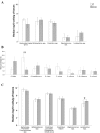Differences in gut microbiota composition between obese and lean children: a cross-sectional study
- PMID: 23631345
- PMCID: PMC3658928
- DOI: 10.1186/1757-4749-5-10
Differences in gut microbiota composition between obese and lean children: a cross-sectional study
Abstract
Background: An altered gut microbiota composition has recently been linked to obesity. The principal aim of this study is to investigate and compare the gut microbiota composition in obese and lean children. Secondly, associations between analysed gut bacterial species, dietary compounds, energy intake and biochemical blood parameters are evaluated.
Methods: In this prospective cross-sectional study, 26 overweight/obese (mean BMI: 28.7 ± 6.5) and 27 lean (mean BMI: 16.5 ± 2.1) children aged 6 to 16 were included. Faecal samples were collected and subjected to selective plating and quantitative real-time PCR (qPCR) in order to determine the concentrations of bacterial species belonging to the genera: Bacteroides, Bifidobacterium, Clostridium, Staphylococcus and Lactobacillus. Matrix-assisted laser desorption/ionization time-of-flight mass spectrometry (MALDI-TOF MS) was applied for an in-depth identification of species of Bacteroides fragilis group. Differences in the concentrations of gut bacterial species between obese and lean children were statistically analysed using Mann Whitney U test. Subsequently, random forest analysis and multiple linear regression analysis were performed in order to test associations between gut bacterial species, dietary compounds and blood parameters.
Results: Obese children showed an elevated Firmicutes-to-Bacteroidetes ratio compared with lean children. Furthermore, low relative proportions of B. vulgatus and high concentrations of Lactobacillus spp. were observed in the obese microbiota. In all children, Staphylococcus spp. were positively associated with energy intake. Additionally, in obese children, Lactobacillus spp. were positively associated with plasma hs-CRP.
Conclusions: Our findings corroborate a significant difference in the gut microbiota composition of important bacterial species between obese and lean children. In future, non-invasive manipulation of gut microbiota composition in early infancy could offer a new approach to manage childhood obesity and associated disorders.
Figures


References
-
- Weiss R. Metabolic syndrome in childhood - causes and effects. Endocr Dev. 2010;19:62–72. - PubMed
LinkOut - more resources
Full Text Sources
Other Literature Sources
Medical
Molecular Biology Databases
Research Materials
Miscellaneous

